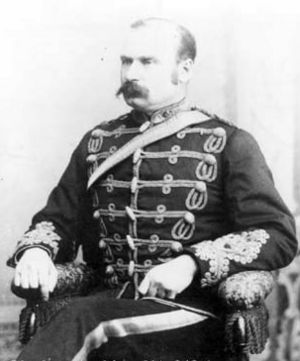Leif Newry Fitzroy Crozier facts for kids
Quick facts for kids
Leif Newry Fitzroy Crozier
|
|
|---|---|

L.N.F. Crozier c. 1880
|
|
| Born | 11 June 1846 Newry, Ireland, UK |
| Died | 25 February 1901 (aged 54) Cushing, Oklahoma Territory |
| Buried | |
| Allegiance | Dominion of Canada |
| Service/ |
Canadian Militia North-West Mounted Police |
| Years of service | 1863-1873 (Canadian Militia) 1872-1886 (NWMP) |
| Rank | Major (Canadian Militia) Assistant Commissioner (NWMP) |
| Battles/wars | Fenian Raids North-West Rebellion |
| Other work | merchant and banker |
Leif Newry Fitzroy Crozier (born June 11, 1846 – died February 25, 1901) was an important officer in the Canadian Militia. He also served as a superintendent for the North-West Mounted Police (NWMP). This police force is now known as the RCMP. Crozier is best known for his part in the North-West Rebellion of 1885. This was a resistance movement led by Métis leader Louis Riel in what is now Saskatchewan.
Early Life and Military Start
Crozier was born in June 1846 in Ireland. His family later moved to Canada. They settled in a town called Belleville, Ontario. In Belleville, he tried different jobs. He worked in printing, in stores, and in a lawyer's office. He also studied at a medical college for a while.
But Crozier's biggest interest was always the military. When he was just 16, he joined the Canadian Militia. He served during the Fenian raids, which were attacks by Irish-American groups. By 1873, he had become a major in the militia.
Career with the NWMP
In 1872, Crozier joined the NWMP as a Sub-Inspector. He was promoted to Inspector the next year. While working for the police, Crozier saw how hard life was for First Nations people. Their main food source, the buffalo, was disappearing.
By 1884, Crozier was the Superintendent at Fort Carlton. He warned Lieutenant-Governor Edgar Dewdney that government rules were making First Nations and Métis people unhappy. He worried that a conflict like the earlier Red River Rebellion might happen again. So, he asked for more police to be sent to the North-West.
Crozier wanted to avoid fighting. He tried to talk with Louis Riel to find a peaceful solution. However, they could not agree, and the situation remained tense.
On March 26, 1885, Crozier led about 100 mounted police and volunteers from Fort Carlton. They were going to get supplies for the fort. Near Duck Lake, Saskatchewan, they met Gabriel Dumont and a larger group of Métis. No shots were fired at first, and the police went back to Fort Carlton.
Soon after, the Battle of Duck Lake happened. The NWMP were defeated by the Métis. This battle started the resistance that Crozier had hoped to avoid. On March 21, 1885, Louis Riel had sent Crozier a letter. Riel demanded that Crozier surrender. He also threatened to fight against those who opposed the Métis' rights. The police's retreat from Duck Lake made the NWMP look bad.
After the Battle of Duck Lake, Crozier's role in the rest of the rebellion was small. His police force mostly stayed at their post in Battleford, Saskatchewan. His decision to march to Duck Lake and into an ambush slowed down his career with the NWMP.
However, on April 1, 1885, he was promoted to Assistant Commissioner of the NWMP. He held this job until he retired in 1886. He resigned because the Prime Minister, Sir John A. Macdonald, chose a civilian to be the new commissioner instead of him.
Crozier spent his later years working as a merchant and banker in Oklahoma Territory. He died from a heart attack in Cushing, Oklahoma Territory on February 25, 1901. His body was brought back to Belleville, Ontario, where he was buried.
See also
Saskatchewan Herald, Articles on the Frog Lake Massacre, Article Carlton
Images for kids


